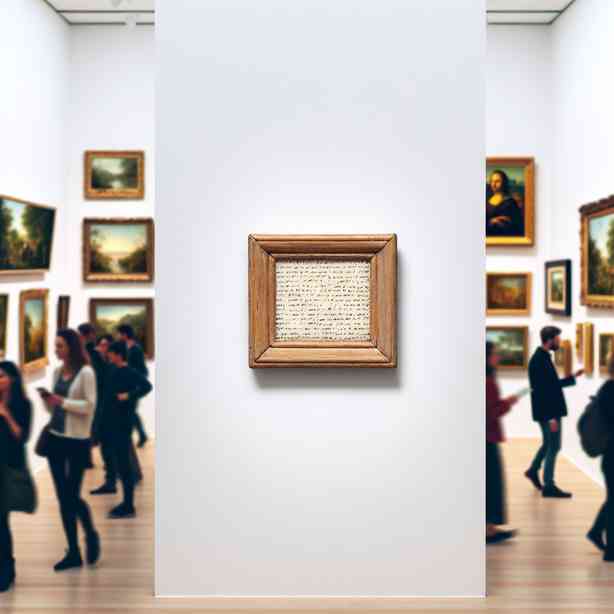
The concept of a gallery label might seem straightforward at first glance, but it contains a depth of complexity that often goes unnoticed. A gallery label is typically a small sign positioned next to a piece of art, providing context, commentary, and sometimes even a narrative that enriches the viewer’s experience. However, there are instances when these labels may not fulfill their intended purpose, leaving viewers underwhelmed or confused. This phenomenon raises questions about the importance and the impact of effective labeling in art galleries.
To understand the significance of a gallery label, we first need to consider its primary functions. Firstly, gallery labels serve as informational guides, providing details such as the artist’s name, the title of the artwork, the medium used, and the year it was created. This basic information is crucial for establishing a connection between the viewer and the artwork. Without it, one might simply appreciate the colors, shapes, or forms without delving deeper into the artist’s intent or the historical context surrounding the piece. However, it is essential that these labels do not merely present facts; they must also engage the viewer’s interest and curiosity.
Moreover, effective gallery labels strive to offer insights into the themes, techniques, and concepts behind the artwork. They can convey the artist’s motivations or the cultural significance of the work, transforming a passive viewing experience into an active dialogue between the viewer and the art. In this way, a well-crafted gallery label can help demystify complex art pieces, making them more accessible to a broader audience. Conversely, a poorly written or overly simplistic label can lead to misunderstanding or a lack of engagement. This is often where viewers feel the label has said “too little,” failing to provoke further exploration or contemplation.
One of the most common challenges in gallery labeling is the balance between brevity and depth. Many labels aim for conciseness, which can lead to essential details being omitted. While it is important to provide information in a digestible format, an overly concise label may deprive the viewer of critical insights that enhance their understanding. An effective label should invite curiosity and encourage further inquiry, striking a balance that respects the viewer’s time while also fostering a deeper appreciation for the art.
Additionally, the language used in gallery labels plays a crucial role in shaping the viewer’s experience. Labels can sometimes come across as overly academic or jargon-laden, creating a barrier for casual viewers who may not have a background in art history or theory. Conversely, overly simplistic language can undermine the complexity of the artwork, reducing it to something trivial. Thus, finding the right tone—one that is engaging yet informative—is key to successful gallery labels. It is a delicate dance that requires an understanding of the audience, the artwork, and the cultural context.
Art institutions are increasingly aware of the need for inclusivity in their exhibitions. This includes tailoring gallery labels to cater to diverse audiences, including those who may have disabilities or varying levels of education about art. Multilingual labels, tactile displays, and audio guides are just a few ways galleries are attempting to broaden their accessibility. In this vein, a gallery label that effectively communicates its message can foster a sense of belonging among viewers and encourage them to engage more deeply with the art on display.
Another important aspect to consider is the role of storytelling in gallery labeling. Art often tells a story, whether through its subject matter, technique, or its relationship to the artist’s life or the broader socio-political context of the time it was created. A gallery label that embraces storytelling can transform the experience by allowing viewers to connect emotionally with the artwork. This narrative element can create a richer layer to the viewing experience, prompting questions and reflections that extend beyond the gallery walls.
Ultimately, the art of crafting effective gallery labels is about respect—respect for the artwork, the artist, and most importantly, the audience. It is about recognizing that every piece of art has the potential to resonate with viewers in different ways, and that the labels guiding them should facilitate that connection. They should not only inform but also inspire curiosity and contemplation. The challenge lies in achieving this goal while navigating the constraints of space, language, and audience diversity.
In conclusion, while gallery labels may seem like mere annotations, they are, in fact, powerful tools that enhance the art viewing experience. A label that says “too little” can leave viewers with more questions than answers, while one that resonates with clarity and depth can transform their experience entirely. As galleries continue to evolve and adapt, the importance of thoughtful and effective labeling will undeniably remain a cornerstone of how art is interpreted and appreciated in contemporary society. As curators, artists, and institutions continually strive for excellence in this area, the dialogue between art and viewer can only deepen, fostering a more engaged and informed audience in the process.


